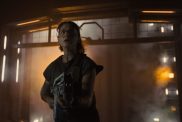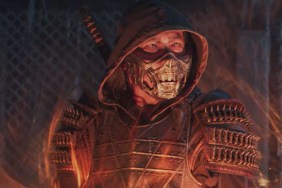
The Texas Chain Saw Massacre is a perfect horror film. From an aesthetic and narrative standpoint, it is one of the most emulated genre films of the last half century. It has its roots in the bloody chamber archetype, the Hansel and Gretel fairy tale and the literary notion of the Bluebeard. Put simply, it is the cinematic incarnation of the most primal fear mankind experiences, that of being captured and eaten by an animal more vicious than ourselves.
Certainly the elemental terror of being trapped, tortured and consumed is grisly fodder enough to base a film around. But Tobe Hooper‘s 1974 masterpiece uses that as merely the foundation for a multi-layered treatise on the post-Watergate, post-Vietnam cultural schism America was then roiling in. The echoes of the Manson family’s ruinous effect on the peace generation reverberate through every frame and the sordid, predatory impulse inherent in Western capitalism is laid bare by the actions of the central antagonists.
How much of this trenchant subtext first time director Hooper consciously imbued the film with is debatable, but its efficacy and continuing relevance is not. Transitioning to a feature from his drug soaked student film Eggshells (watch it here), Hooper figured a low budget horror film the easiest way to get a foothold in the industry, a tack having previously worked for the likes of Francis Ford Coppola and Peter Bogdanovich.
Being terrified by tales his mid-western relatives told him in his youth of Wisconsin serial killer Ed Gein planted the seeds for the ghoulish family of laid off slaughterhouse workers that would terrorize the hapless hippies in his horror opus. However, the creative lightning strike that birthed a legend and subsequent franchise was Hooper imagining a chainsaw he spied in the hardware section of a busy department store being utilized to cut a swath through the throngs of shoppers. He now had his villains, the iconic weapon and the films salacious hook.
Shot in Texas during a blistering August in 1973, the production was a famously arduous ordeal. One during which relative insanity set in amongst the cast and crew, culminating in a 30 hour day spent filming the climactic dinner sequence. The fetid mania in the finished scene is palpable. With windows closed off to approximate night time, temperatures soared to 125 degrees in the house. The meat used as set dressing rapidly rotted, giving off an intolerable stench that prompted the crew to regularly rush outside and retch in the bushes.
After multiple unsuccessful takes of a key sequence, Leatherface actor Gunnar Hansen lost his composure with a malfunctioning special effect and removed the guard on his blade so as to actually cut Marilyn Burns finger and bring the scene to completion. Hansen has gone on record stating that during this moment he completely lost sight of the distinction between himself and the loathsome maniac he was portraying. To say this was a troubled shoot is an understatement of epic proportions, but the visceral authenticity these conditions produced can’t be denied.
Once finished and released, the film was a surprise critical success and financial smash hit. Unfortunately, the company that ushered it into theaters (Bryanston) was a mob front for money laundering and no one involved in the film’s creation ever saw their share of its substantial earnings. Only Hooper went on to have much of a career as a result of its acclaim, and save for a very few exceptions, most of the cast and crew bitterly resent him to this day for that lamentable fact.

The bulk of the accolades were bestowed upon the manner in which the avant garde soundtrack (also by Hooper) and sun burnt cinematography contributed to the believably grimy milieu. The tracking shot following Pam (Teri McMinn) as she approaches the sinister house has deservedly become legendary. Yet Hooper’s keen eye somehow finds a way to elevate even a static shot of a gas powered generator to high art. Indeed, many years on, the shot composition and poetic transitions remain stunning artistic achievements, especially considering the miniscule budget and relative inexperience of Hooper and his cinematographer Daniel Pearl.
What wasn’t as widely discussed at the time of its release, were the many instances of pitch black humor and mordant social commentary. The intervening four decades have provided ample time for this to become transparent and for those of us so inclined to theorize as to its greater meaning.
The Texas Chain Saw Massacre is a film about the degenerative neuroses of the patriarchal white male mindset. It portrays the manifest destiny impulse that ignited the industrial revolution as stemming from a poisonous, all-consuming greed. It is the eventual souring of the corporate business model and how that inevitably leads to compulsive societal cannibalism.
Consider Jim Seidow as the Cook, seemingly a kindly old shopkeeper, in actuality an abusive head of a malignantly dysfunctional family. A family devoid of any legitimate feminine influence, their entire existence revolves around procurement of the next meal and the aggregation of material goods unwillingly contributed by the unfortunates they ensnare. The original hoarders, the Chainsaw clan’s yard is littered with the trinkets, vehicles and general detritus of those they devour as the inside of their home is awash in their bones.
At one point, the cook tellingly exclaims to final girl (Chainsaw originated this convention) Sally Hardesty, “There’s some things you got to do in life, that don’t mean you have to like it”. The most fascinating aspect of these bogeymen is they don’t consider the crimes they perpetrate as a matter of right or wrong so much as an unpleasant, but necessary by-product of their ingrained way of life. These are warped, perverted men living an outmoded existence predicated on the suffering and death of others. They are incapable of change and when faced with representatives of a progressive society outside of their entrenched madness, choose to exert their power and ultimately consume them.

As much as I adore the Cook for serving as a surrogate for the pragmatic capitalist, Leatherface is the film’s stand out villain. Infinitely more psychologically complex than the spate of imitators that cropped up in his wake. He’s a shambling, distorted mirror image of a human being. He isn’t the alpha hunter here that he became in later iterations. He’s as scared of the teenagers invading his homestead as they are of him.
Leatherface’s defining moment as a character occurs after he kills Jerry with a devastating hammer blow, then runs frantically to the front window to peer out the drapes. He scans to make sure there aren’t any more intruders to deal with. Once satisfied his home protection duties are complete, he collapses in a nervous heap and starts wringing his hands and licking his lips, emotionally exhausted by the day’s upheaval.
Leatherface is whatever his family needs him to be. He even becomes a matronly presence in the kitchen, donning a grandma wig and feminine makeup. He silently suffers the abuse and disregard from his brother and father figure as the family matriarch would in an oppressive domestic environment common to the time. His masks, fashioned from the faces of his victims, aren’t so much war paint designed to intimidate as they are a device to strip him of all individuality. As in any domineering family structure, his persona is obliterated, then absorbed into the collective, his wants and desires irrelevant trivialities.
The Grandpa character is perhaps the most prescient exemplar for where patriarchal capitalism was headed at the dawn of the new millennium. He is an impotent vampire, inexplicably revered and deferred to by his offspring. He literally must taste the plasma of a nubile youth to become animated and once his blood lust is aroused, he lacks the sufficient strength to finish her off. A grotesque monument to inefficiency and cancerous tribalism, Grandpa set the sadistic example for his kin and they’ve viciously followed suit in his incapacitated stead. The sins of the father passed down through polluted blood.
The most compelling aspect of The Texas Chain Saw Massacre isn’t the manner in which these degenerates terrorize American youth, it’s how they mirror the dysfunctional nuclear family and embody the end result of its calcified, unchallenged reign. Tobe Hooper well understands the most psychologically damaging incidents to typically befall most Americans occur within the purported comfort and safety of the home.
The inimitable alchemy of The Texas Chain Saw Massacre is to be found in the way Hooper captures lightning in a bottle artistically and grafts archetypal fears onto generational disconnect and mistrust. He then seasons this heady stew with a liberal dose of Freudian familial neuroses. Entirely intentional or not, the end result is a watershed moment for the genre and a film that will be discussed and analyzed for equally as long as its revolutionary forbears from the silent era.
The Texas Chain Saw Massacre is both of its time and timeless, the rarely achieved goal of any serious work of art.









